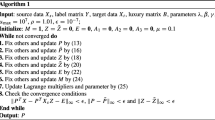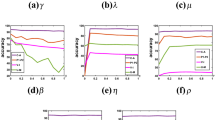Abstract
By leveraging the labeled data samples of the source domain to learn the unlabeled data samples of the target domain, unsupervised domain adaptation (DA) has achieved promising performance. However, it is still a vital problem for unsupervised domain adaptation to deal with cross-domain distribution mismatch. Therefore, we present a new model framework for cross-domain image classification in the paper, which is termed manifold transfer subspace learning based on double relaxed discriminative regression (MTSL-DRDR). First, the global geometry information of the samples from the source and target domain can be preserved by utilizing the low-rank constraint. Second, the two transformation projections are employed to project both domains to a unified subspace, in which each data sample of the target domain can be represented by some samples from the source domain with the sparse and low-rank coefficient matrix. Third, the local structure information of the data points with the same semantics from the different domains is preserved by means of the adaptive weight graph based on the low-rank coefficient matrix. Last, for fully use the discriminative information of data from the source domain, the discriminant information of the source domain based on intra-class and inter-class graphs is encoded to the target domain. Our MTSL-DRDR algorithm is evaluated on challenging benchmark datasets, and a large number of experiment results show the superiority of the proposed method.














Similar content being viewed by others
References
Belhumeur PN, Hepanha JP, Kriegman D (1997) Eigenfaces vs Fisherfaces: recognition using class specific linear projection. IEEE Trans Pattern Anal Mach Intell 19(7):711–720
Bertsekas DP (1982) Constrained optimization and Lagrange multiplier methods. Academic Press
Cai J-F, Candès E, Shen Z (2010) A singular value thresholding algorithm for matrix completion. SIAM J Optim 20(4):1956–1982
Chang HY, Zhang FL, Gao GW et al (2020) Graph-structure constraint and schatten p-norm based unsupervised domain adaptation for image classification. J Ambient Intell Human Comput. https://doi.org/10.1007/s12652-020-02350-y
Deng WY, Lendasse A, Ong Y et al (2019) Domain adaption via feature selection on explicit feature map. IEEE Trans Neural Netw Learn Syst 30(4):1180–1190
Eckstein J, Bertsekas DP (1992) On the Douglas-Rachford splitting method and the proximal point algorithm for maximal monotone operators. Springer-Verlag, New York
Jhuo IH, Liu D, Lee DT et al. (2012) Robust visual domain adaptation with low-rank reconstruction. In CVPR, pp. 2168–2175.
Jiang WH, Gao HC, Lu W et al (2019) Stacked robust adaptively regularized auto-regressions for domain adaptation. IEEE Trans Knowl Data Eng 31(3):561–574
Kan SC, Cen Y, Cen YG et al (2021) Zero-shot learning to index on semantic trees for scalable image retrieval. IEEE Trans Image Process 30:501–516
Lin Z, Chen M, Ma Y (2010) The augmented lagrange multiplier method for exact recovery of corrupted low-rank matrices. arXiv preprint arXiv:1009.5055
Liu G, Lin Z, Yan S et al (2013) Robust recovery of subspace structures by low-rank representation. IEEE Trans Pattern Anal Mach Intell 35(1):171–184
Liu F, Zhang GQ, Lu J (2020) Heterogeneous domain adaptation: an unsupervised approach. IEEE Trans Neural Netw Learn Syst 31(12):5588–5602
Liu WF, Li JF, Liu BD et al (2021) Unified cross-domain classification via geometric and statistical adaptations. Pattern Recogn 110:107658
Liu ZH, Shi KM, Niu DM et al (2023) Dynamic classifier approximation for unsupervised domain adaptation. Signal Process 206:108915
Long M, Wang J, Ding G, et al. (2013) Transfer feature learning with joint distribution adaptation. ICCV, pp. 2200–2207
Long M, Wang J, Ding G, et al. (2014) Transfer joint matching for unsupervised domain adaptation. Proc. IEEE CVPR, Jun, pp. 1410–1417
Lu YW, Wang WJ, Yuan C et al (2021) Manifold transfer learning via discriminant regression analysis. IEEE Trans Multimedia 23:2056–2070
Lu YW, Wong WK, Zeng BQ et al (2023) Guided discrimination and correlation subspace learning for domain adaptation. IEEE Trans Image Process 32:2017–2032
Pan SJ, Tsang IW, Kwok JT et al (2011) Domain adaptation via transfer component analysis. IEEE Trans Neural Netw Learn Syst 22(2):199–210
Shao M, Kit D, Fu Y (2014) Generalized transfer subspace learning through low-rank constraint. Int J Comput Vision 109(1–2):74–93
Si S, Tao D, Geng B (2010) Bregman divergence-based regularization for transfer subspace learning. IEEE Trans Knowl Data Eng 22(7):929–942
Tao J, Xu H, Fu J (2019) Low-rank constrained latent domain adaptation co-regression for robust depression recognition. IEEE Access 7:145406–145425
Wang LC, Ding ZM, Fu Y (2019) Low-rank transfer human motion segmentation. IEEE Trans Image Process 28(2):1023–1034
Xiang SM, Nie FP, Meng GF et al (2012) Discriminative least squares regression for multiclass classification and feature selection. IEEE Trans Neural Netw Learn Syst 23(11):1738–1754
Xiong H, Wan R, Zhao J, Chen Z, Li X, Zhu Z, Huan J (2022) Grod: deep learning with gradients orthogonal decomposition for knowledge transfer, distillation, and adversarial training. ACM Trans Knowl Discov Data 16(6):117
Xu Y, Fang XZ, Wu J et al (2016) Discriminative transfer subspace learning via low-rank and sparse representation. IEEE Trans Image Process 25(2):850–863
Xu X, Lin KY, Yang Y et al (2022) Joint feature synthesis and embedding: adversarial cross-modal retrieval revisited. IEEE Trans Pattern Anal Mach Intell 44(6):3030–3047
Yan S, Xu D, Zhang B et al (2007) Graph embedding and extensions: a general framework for dimensionality reduction. IEEE Trans Pattern Anal Mach Intell 29(1):40–51
Zhang L, Zuo WM, Zhang D (2016) LSDT: Latent sparse domain transfer learning for visual adaptation. IEEE Trans Image Process 25(3):1177–1191
Zhang L, Wang S, Huang G et al (2019) Manifold criterion guided transfer learning via intermediate domain generation. IEEE Trans. Neural Netw Learn Syst 30(12):3759–3773
Zhang C, Li HX, Qian YH et al (2021) Pairwise relations oriented discriminative regression. IEEE Trans Circ Syst Video Technol 31(7):2646–2660
Zhang C, Li HX, Qian YH et al (2022) Locality-constrained discriminative matrix regression for robust face identification. IEEE Trans Neural Netw Learn Syst 33(3):1254–1268
Zhao C, Li HX, Chen CL et al (2022) Enhanced group sparse regularized nonconvex regression for face recognition. IEEE Trans Pattern Anal Mach Intell 44(5):2438–2452
Zhu F, Gao J, Yang J et al (2022) Neighborhood linear discriminant analysis. Pattern Recogn 123:108422
Funding
This work was supported in part by NSFC of China (U1504610, 61971339).
Author information
Authors and Affiliations
Contributions
ZL wrote the main manuscript text, FZ, KZ, ZL and HH reviewed the manuscript.
Corresponding author
Ethics declarations
Competing interest
The authors declare no competing interests.
Additional information
Publisher's Note
Springer Nature remains neutral with regard to jurisdictional claims in published maps and institutional affiliations.
Rights and permissions
Springer Nature or its licensor (e.g. a society or other partner) holds exclusive rights to this article under a publishing agreement with the author(s) or other rightsholder(s); author self-archiving of the accepted manuscript version of this article is solely governed by the terms of such publishing agreement and applicable law.
About this article
Cite this article
Liu, Z., Zhu, F., Zhang, K. et al. Manifold transfer subspace learning based on double relaxed discriminative regression. Artif Intell Rev 56 (Suppl 1), 959–981 (2023). https://doi.org/10.1007/s10462-023-10547-8
Accepted:
Published:
Issue Date:
DOI: https://doi.org/10.1007/s10462-023-10547-8




